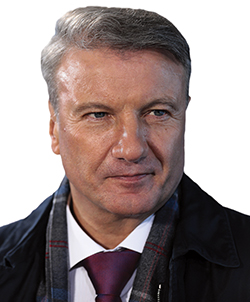Sberbank, Russia’s largest lender, is rapidly turning itself into a technology giant. Once the country-wide controller of Russia’s savings offices, the bank dates back to the 19th century. While still majority state-owned, little of the lender’s past remains thanks to ambitious reforms and the management’s embrace of technology.
With a year to go before the end of its 2014-18 Development Strategy, Sberbank is working on a new three-year corporate strategy focused on transforming the business into Russia’s largest fintech operation.
“We are moving from inside transformation, improvement in profitability and better services to building an ecosystem with Sberbank as a core centre, a new technological and financial platform,” says president and chief executive Herman Gref. “We would like to expand into new businesses around the financial sector. It is a very ambitious goal but it means that we also need to have very high-level technological skills, not only financial skills, to be able to attract lots of different businesses around our bank.”
Sberbank will detail its strategy at the end of 2017, and will set out “areas in which we would like to expand in the next three to five years” and the financial results the bank seeks to achieve in these areas, according to Mr Gref.
“I believe that in the banking business margins will slow down,” he says. “The only chance we have to be dynamic, profitable enough, and able to bring our shareholders a good return on equity in the future is by expanding into the new business areas.”
Crisis aftermath
To determine target areas for growth, Sberbank is analysing the landscape and the potential needs of Russian clients in 2025.
“We try to define the areas around our clients which are very closely related to our core banking and financial business,” says Mr Gref. “We would like to make our services so convenient for our clients that in 2025 they can access any service they need through Sberbank.”
Being able to communicate a client's needs at the push of a button, or even for Sberbank to foresee their requirements, is a challenge Mr Gref is keen to take on.
Often criticised in the past for being bureaucratic and slow-moving, Sberbank has already made significant changes. One indicator of increasing efficiency is its falling cost-to-income ratio (CIR), but this improvement did not necessarily happen by choice.
“The crisis of 2014 and 2015 was very painful for us,” says Mr Gref. “But it meant we accelerated our organisational and structural reforms inside the bank and this has helped us achieve very good results cutting our expenditures. We have also benefited from moving towards digitalisation so fast.”
According to The Banker Database, Sberbank’s CIR fell from 41.73% at the end of 2012 to 35.79% in 2016, a low figure for a lender of Sberbank’s size, and among the lowest in Russia.
International status
Outside Russia, Sberbank is facing challenges to its international business. Sanctions were imposed on Sberbank and other Russian state-owned banks operating in Ukraine in March. Sberbank announced plans to sell its Ukrainian operations to two Russian businessmen a month later, but the sale was blocked in July by the National Bank of Ukraine.
Meanwhile, in Europe, Mr Gref feels regulators are having a negative impact on the bank’s operations. “It is very difficult to operate in Europe because there is such high pressure from the European Central Bank,” he says. “We have had 11 different supervisory inspections for one small bank. I think that is too many.”
But that does not mean retreating from its Vienna-headquartered European business, says Mr Gref, the bulk of which Sberbank acquired from Volksbank in 2012. “We would like to be in the European market but I think we must lighten our new business model there,” he says, a strategy which he adds will include some branch closures.
Across its entire operation, Sberbank has been reducing branch numbers from more than 19,000 in 2012 to about 15,000 at the end of 2016, according to The Banker Database. Through increasing the use of artificial intelligence, Sberbank is further planning to reduce back-office staff numbers from some 12,000 people to 1000 by 2021, further cutting costs.
Ultimately, Russia’s largest lender is also seeking to implement its new digital platform across all its European businesses. But until Sberbank reveals the details of its strategy, it remains to be seen what advantages will arise, apart from the distinction of being Russia’s largest fintech.












